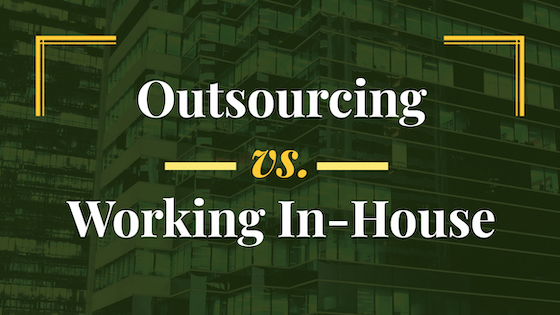Outsourcing vs. Working In-House
Every business chooses to run its operations differently from the next one. Utilizing your own team’s strengths and abilities is often a goal. However, this is not always feasible for every task at hand. Your team may require the expertise of someone whose knowledge is beneficial but who would not always be necessary to have on hand. In addition, your company may not be big enough to handle all of its needs under its own building. They also may simply not have the resources to do so. Outsourcing may be the way to go about any of these circumstances.
In this guide, we’ll offer our perspective on when it is appropriate to keep resources in-house vs. when you should outsource. While what we have to say will likely not apply to every company, this is simply to get you thinking about what you can do for your own company.

Working In-House
First of all, how does having full-time employees benefit your business?
When someone is working full-time with your company, they are investing their skills solely into one place. Employees can learn directly from one another and offer encouragement while working alongside one another. Your team will likely always be available for one another since you all (most likely) will work the same hours in a day, whether you work in-house or remotely. On top of all of this, everyone will understand the company’s mission/culture best and will work to carry this out. In other words, there aren’t discrepancies since everyone knows how the company is run.
However, having all in-house employees is not always the best in the long run. For one thing, there isn’t always 40 hours of work in a week for a single person to do. When a job role only requires, say, 15-20 hours worth of work weekly, this is going to cost your business more. After all, you must pay your employee for the full 40 hours or more that they are on the clock. In addition, your employees may not have the skillsets for everything you are asking of them with the business. For example, if you run a graphic design company, chances are that your designers don’t have the expertise to handle the company’s finances.

Outsourcing
What can you do in the case that you don’t have enough work to hire someone full-time but still need that person to fill a specific role for your company? You can choose to outsource the work to a different company. In this case, the employees specialize in the work you are seeking out.
For example, Colortech often fills a role for many companies with everything that we offer. Companies not only utilize our offset and digital printing services but also our fulfillment, mailing, creative, and more. We will often fill a gap for when places need something accomplished but don’t have the means or the resources to do so in-house.
One benefit of outsourcing includes being much more cost-effective. Contractors will only bill you for the exact amount of hours worked. This is often less than half the amount of time you would need to pay someone working full-time for your company. With this, businesses are able to pick and choose exactly when to utilize these contractors, and full-time employees are also able to focus more on their tasks at hand. They don’t have to worry about matters not related to their job positions.
Despite these advantages, outsourcing has plenty of drawbacks as well. While you can always rely on your full-time employees to be readily available, this isn’t something you can expect of your contractors. After all, they more than likely are working with multiple companies at a time. Because of this, expect your communication to be much less frequent than with your regular employees. You will also have less control over the projects you hand over to contractors. They are working with their own schedules and, again, with other clients. The way they accomplish their tasks may not be the way your business would normally go about it. However, since they are not employed with you full-time, this is something you will need to accept.

How Do I Know What’s Best for My Company?
As we said before, every company will want to run things differently. Here’s what we can say for certain. Having employees full-time provides fast communication and reliable team building. Nonetheless, outsourcing can increase productivity and reduce some of your costs.
There is no right or wrong way to go about building your team. You simply need to evaluate the needs of your business, which can always change over time. Maybe someday, your graphic design company is bringing in enough income to warrant employing that full-time financial advisor. Until then, there’s nothing wrong with outsourcing that position and keeping to what you can reasonably afford to accommodate.
On the other hand, if you have the means and want to prioritize having an available team that can accomplish everything your business sets out to do, you can absolutely do that as well.
It’s okay to be stumped as to what is the best decision for your business. We would suggest sitting down, figuring out what exactly your needs are as a business, and then going from there.
To keep it simple, you want to have the right people doing exactly what they are good at. For example, let’s say your business is given a bigger advertising budget than usual. Your sales team wants to try something new but isn’t sure where to start. It may be worth it to hire an expert marketing consultant to work with your sales team for 10 hours a week and help come up with a strategic marketing plan, rather than your sales team spending many more hours trying to figure it out themselves and then ultimately failing.
To summarize, it’s important to focus on the core aspects of your business and what you want to offer rather than spending time and resources on matters you don’t know much about. However, don’t forget to lean on your own employees and have them offer suggestions as well. You may be surprised to learn what they can bring to the table.

